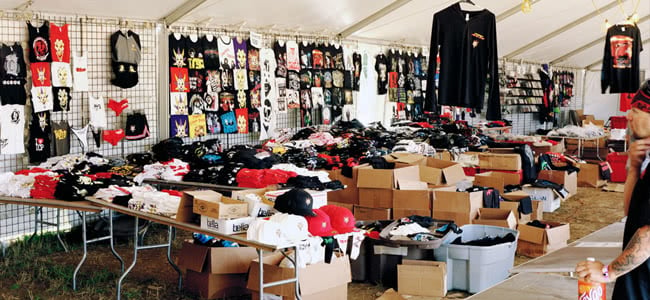With music sales declining each year, bands and artists have staged something of a mass exodus out of the field of recorded music and into other areas in order to make money. While recorded music certainly isn’t going away, it’s not exactly a cash cow for artists.
In addition to live performance and touring, merchandise has become something of a crucial revenue source for bands and artists, with many citing merch sales as one of their primary sources of revenue and have begun investing vast amounts of time, effort, and money in desirable new merch.
Flight Facilities made an awesome flight pack, Peking Duk created a hilarious ‘Festival Survival Kit’, and Violent Soho designed a limited edition Simpsons-inspired T-shirt that sold out in minutes. To help you get on the gravy train, we’ve recruited two of Australia’s most renowned merch experts.

Brian “BT” Taranto has been involved in the world of concert merchandise since 1985. A bonafide veteran of the industry, Brian got his start as an employee of Australian Tour Merchandising (ATM). In the late 1990s, Brian launched Love Police, a company and brand that has gone on to be a force of the industry, producing merchandise, promoting concerts and tours, and even venturing into graphic design and book publishing. In 2011, Love Police merged its merchandising interests with ATM to create the country’s biggest merch company, LPATM.

Duane Jackson is the manager of 24HUNDRED, a leading name in online and physical merchandise, apparel, and music retail in Australia. While initially specialising in punk, hardcore and metal through the UNIFIED group, 24HUNDRED have since expanded to cover hip-hop, rock, and pop whilst serving as the Australian distributor for the likes of Epitaph, MerchConnection, MerchNow, Impericon, and numerous other labels. Prior to his position at 24H, Duane was the National Coordinator for Attractive Promotions and worked various jobs in warehousing, logistics, and design & print.
Know Your Fans
Brian: “Generally speaking, band merch is worn by passionate fans of a band who wants to show their colours. Keeping this in mind is obviously the way to go with album covers, tour artwork, band logos etc. With the onset of indie bands, trying to be a bit cooler and slacker with design or reference can work well… or bomb miserably. You know hipsters, they don’t always want to look like everyone else, even though they do. Sure, hire a designer if you have a vision you think your fans will go for, but don’t overthink it, and don’t overproduce with too many options. And remember, its the fan who is buying and wearing, not you, the band.”
Duane: “It doesn’t matter how cool your band is, or how cool you think your band is, without appealing design, your audience will not want to wear your gear. This doesn’t mean you have to pay Picasso to paint up some sick once-off, but it definitely means you really need to think about the band’s look and image, their message or vibe, and ensure that the merchandise fits this.
Understanding what you want out of your merchandise vibe is imperative from day one. An indie crowd wears different designs that are different aesthetically to say, a death metal fan or a hip hop head. Does your scene love that streetwear look? Does your scene still love multi-colour prints that emblazon the entirety of the front of a? Understand your market, do your research. You’re in the market, you probably wear cool shit – would you wear your own band’s merch? You’d want to hope so.
Like, you know when you’re a bloke (for the sake of this comparison) driving and you see a cute little Hyundai Excel, and it’s got stickers on it, and furry animals in the back window – and you pull up beside it because you’re a creep and you want to check out the driver, and it’s a dude?! Likewise, your merch should fit the aesthetic of your band and your fans.”
Quality Is Everything
Brian: “With the styles of blank shirts and garments around these days, it is hard to not produce merch of a decent quality. The thing to be more aware of is how good the printing is. A quality shirt with a shit print job or bad print size is a shit shirt no matter how excellent the actual shirt is.”
Duane: “Sure, cut costs and save $2 per unit on T-shirt quality, but then deal with all your fans washing your T-shirt once and it falling apart. Not a good look. Would you go to Big W and buy another T-shirt if it fell apart after a few washes? Didn’t think so. But then again, I didn’t think you’d be shopping at Big W for T-shirts.
Just as important as great quality merchandise (because your fans are worth it) is picking the right style of garment to fit your crowd. There’s a lot of great wholesale T-shirt brands out there, from AS Colour, to American Apparel and even Gildan for the old school, but not all scenes love all these styles. For example, a lot of old school punk and hardcore dudes hate the newer style tees that are slimmer and longer and fit more to current trends. Again, do your research! It’s not hard.”
Figure Out What Works
Brian: “Generally speaking, something that captures the vibe of the band should work. Be that a humorous thing or something related to the tour or the ethos of the band. Sometimes current events or recent history can shape some concepts that work well.”
Duane: “Please don’t think you’re bigger than you are. Just because you’ve played a sold-out room of 250 people on a Friday night, it doesn’t mean your fans want to buy custom basketball jerseys at $90 a pop or G-strings with your band name on them. Start with T-shirts and singlets because they work. From there, you can dabble in winter wear (hoodies and crews) and summer items like shorts.
If you are a very artistic and creative band, then you can look at using this to further your merch game. Maybe you’re a sick indie band with a hippie edge, and you’ve just released an album called Wildflower. You just so happen to have a friend who’s a candlemaker and you’ve developed a scent called ‘Wildflower’, so you do a limited edition custom candle. That works. Keep it limited and exclusive and people lap it up.”
[include_post id=”425619″]
This Is Business
Brian: “Never charge too little. It’s my belief that if things are too cheap in comparison to what a regular priced shirt is, people may be wary of quality. It’s also something a band should be proud of, so you shouldn’t feel bad charging market prices for your merch. Generally speaking, shirts at a club-level are $30-35, festival and theatres $40-45, arenas and stadiums $45-50. The reason being as the venues get bigger, so do the charges from the venue to sell at a gig and the costs involved with selling the product, be it extra sellers, security, tents, etc.”
Duane: “Ideally, price for the fan, not for the profit. I know you’re probably only making money off merchandise, but if all your peers are selling tees at $25, what makes your band so special if you’re willing to charge $30 or $40? Price hikes on T-shirts should only be due to excess printing costs (maybe 6-10 colour prints) or special garments (maybe a pricier American Apparel shirt).
Again, you’ve been to enough shows in your scene to see what people are charging. Don’t be greedy – you’re better off selling 100 units of something at $25 than 30 at $30, because those other 70 people are dark at you for trying to charge $5 more.”
Don’t Be Afraid To Get Creative, But Be Smart
Brian: “Our Tenacious D cum rags did surprisingly well and stubby holders work well for some bands. I love the idea of screen-printed posters, but it doesn’t seem to have taken off here as much as I’d like. I love when we can design custom-made headwear, there are a lot of possibilities with that. We have done board shorts and leggings which were killer, but didn’t sell.
It feels like if the punter doesn’t know his/her size instantly, like they do with a T-shirt or hoodie, they tend to shy away from those items.”
Duane: “Merchandise is completely trend based. Things come and go. design styles come and go, unique items come and go. We went through a huge tie dye phase the last couple of years, for example. We tie-dyed tees, tanks, we tie-dyed crew neck jumpers, we bleach-dyed hoodies, it was crazy, but it worked, but you also have to know when to stop flogging a dead horse. If you’re that band selling a trend after the trend died, you look old and dated.
One kind of item you may not have thought of, that we’ve found great success with, are skateboards. They’re collectable, you can display awesome artwork on them, and if you get enough, they’re very affordable vs what you can sell them for. Plus they’re kind of genreless – I’ve seen rad hip-hop decks and sick rock decks, punk decks for sure right through to pure artist-based artwork decks.”
Let’s Talk Numbers
Brian: “Your orders should be based on whatever has a realistic chance of selling and at least covering production costs. With a volume order comes cheaper unit prices, but the 350 shirts that didn’t sell make that good 500-unit price not look so good. You may also get your sizes wrong and be stuck with sizes that don’t sell. The first order of a new design or item is always more expensive because you are paying for design and printing set-up costs in it. But by doing less, you get to see what sizes work and clean up any deficiency in the re-order where the profit margin becomes higher.”
Duane: “Again, understand where you are as a band. Just because printing 50 T-shirts costs more per unit doesn’t mean that it’s smart to print 100 if you’ve got a chance of only selling 40 and then sitting on 60 tees that quickly become deadstock as a style dies. Always start smaller with units — 50 is a good basis — depending on the garment, and then increase your quantities when you see your merch moving out the door quicker than you can keep up. A lot of printers won’t print anything less than 50 as well, because it’s a safe starting quantity.
If you’re a small independent starting off, 20-25 tees is all you really need. I know 50 of your friends said they’d buy one, but they also told you they’d be at all your shows – and where are they now? Exactly.”

































